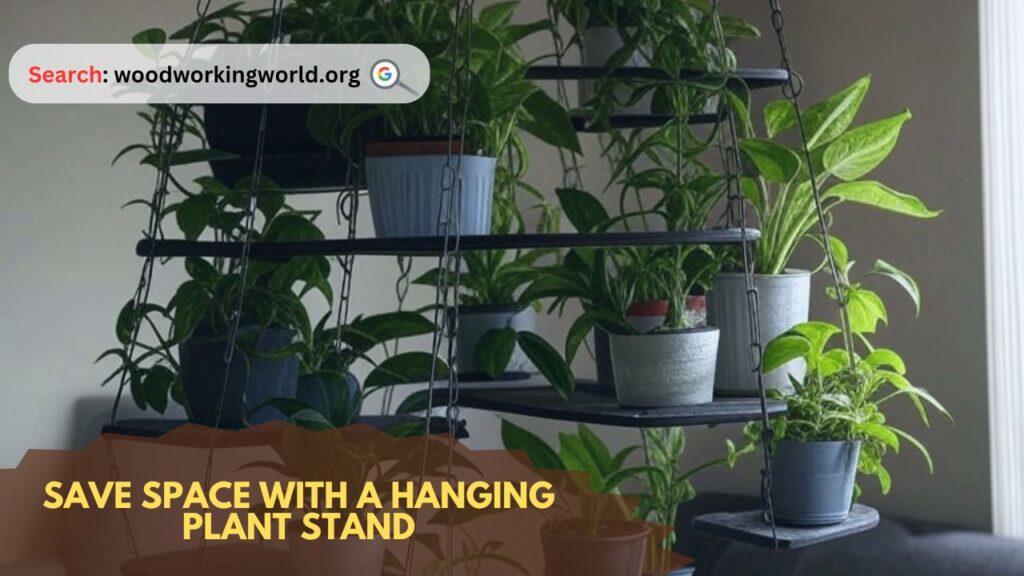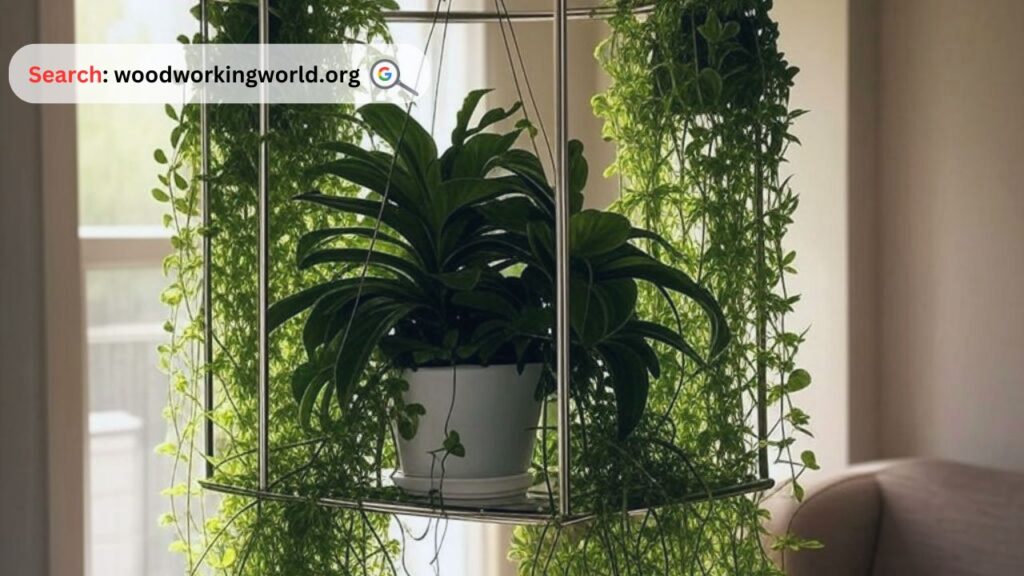Save space with a stylish hanging plant stand! Perfect for small homes, this DIY-friendly idea keeps plants off the floor while adding charm to any room.
Plants bring life, beauty, and freshness to any space. Whether you live in a small apartment, a cozy home, or simply want to maximize your available space, a hanging plant stand is a stylish and practical solution. By using vertical space efficiently, hanging plant stands help you maintain a lush green environment without cluttering your surfaces.

In this guide, we’ll explore everything you need to know about hanging plant stands, from the benefits and step-by-step installation to types and comparisons. Let’s dive into this green revolution!
Benefits of a Hanging Plant Stand
1. Space-Saving Solution
- Ideal for small apartments, balconies, and patios.
- Frees up counter, floor, and shelf space.
2. Improved Aesthetic Appeal
- Adds vertical dimension to your decor.
- Enhances room ambiance with cascading greenery.
3. Health Benefits
- Improves air quality by filtering toxins.
- Creates a calming and stress-relieving atmosphere.
4. Protects Plants from Pets and Pests
- Keeps plants out of reach of pets and small children.
- Reduces the risk of pest infestations from ground-level exposure.
5. Better Sunlight Exposure
- Allows plants to receive optimal light by positioning them at the right height.
- Ideal for trailing and vining plants like pothos, ferns, and ivy.
Build 16,000+ Projects with Step-by-Step Plans—No Big Workshop or Costly Tools Needed! Start Now!
Types of Hanging Plant Stands
Choosing the right hanging plant stand depends on your space, style, and plant needs. Here are some popular options:
| Type | Description | Best For |
|---|---|---|
| Ceiling-mounted | Attached to the ceiling with hooks and chains. | Indoor use, kitchens, living rooms. |
| Wall-mounted | Installed on walls with brackets or rods. | Small spaces, entryways, patios. |
| Freestanding rack | A vertical stand with multiple hanging hooks. | Large collections, outdoor areas. |
| Over-the-door hanger | Hooks over doors with multiple plant holders. | Small apartments, rental homes. |
| Window-mounted | Uses suction cups or brackets for window attachment. | Sun-loving plants, herbs. |
Step-by-Step Guide to Installing a Hanging Plant Stand
Step 1: Choose the Right Location
- Identify a space with adequate light and air circulation.
- Ensure the surface (ceiling, wall, or door) can support the weight of your plants.
Step 2: Gather Necessary Materials
- Hanging plant stand (bracket, rod, or hook setup).
- Screws, nails, or adhesive hooks (depending on the mount type).
- Measuring tape and pencil.
- Drill or screwdriver.
- Hanging chains or macrame hangers.
Step 3: Mark the Installation Points
- Use a measuring tape to mark spots for hooks or brackets.
- Ensure even spacing for multiple plants.
Step 4: Secure the Mounting Hardware
- If using a ceiling-mounted or wall-mounted stand, drill holes and secure screws.
- For over-the-door or window-mounted stands, attach brackets securely.
- Test stability before adding plants.
Step 5: Hang Your Plants
- Use S-hooks or macrame hangers for easy access.
- Adjust heights for aesthetic appeal and proper light exposure.
Best Plants for Hanging Plant Stands
Some plants thrive better in hanging arrangements due to their trailing or cascading growth patterns. Here are some top choices:
Indoor Plants:
- Pothos (Epipremnum aureum): Low-maintenance, air-purifying.
- Spider Plant (Chlorophytum comosum): Hardy, great for beginners.
- String of Pearls (Senecio rowleyanus): Unique beaded foliage.
- Boston Fern (Nephrolepis exaltata): Lush, adds a tropical feel.
- Philodendron: Thrives in indirect light.
Outdoor Plants:
- Petunias: Colorful and vibrant.
- Fuchsia: Attractive to hummingbirds.
- Ivy: Hardy and fast-growing.
- Begonias: Bright blooms with minimal care.
- Geraniums: Classic choice for porches.
Expert tips on Woodworking 🌿📦 Watch now!

Maintenance Tips for Hanging Plant Stands
- Watering: Ensure proper drainage; water slowly to prevent dripping.
- Pruning: Trim dead leaves and vines for a tidy look.
- Cleaning: Wipe down stand and hooks to prevent dust accumulation.
- Rotation: Rotate plants occasionally for even growth.
- Fertilization: Feed plants with diluted fertilizer monthly.
“To plant a garden is to believe in tomorrow.” – Audrey Hepburn
Frequently Asked Questions (FAQs)
1. Can I install a hanging plant stand in a rental home?
Yes! Opt for over-the-door, suction-based, or adhesive hook plant stands that don’t require drilling.
2. How do I prevent my hanging plants from dripping water?
Use pots with drainage trays or double potting (a liner pot inside a decorative one) to catch excess water.
3. What is the weight limit for a ceiling-mounted plant stand?
It depends on the hardware used. Heavy-duty hooks can support 10–50 lbs. Always check the anchor strength before hanging heavy plants.
4. Are there smart hanging plant stands available?
Yes, some modern hanging stands feature built-in self-watering systems, LED grow lights, or moisture sensors.
5. What is the best way to hang multiple plants without overcrowding?
Use staggered heights and different hook placements to create a layered effect while ensuring each plant gets enough light.

Conclusion
A hanging plant stand is an excellent way to save space, enhance your decor, and improve your indoor or outdoor gardening experience. Whether you choose a ceiling-mounted, wall-mounted, or freestanding option, the right stand will help you make the most of your available space while keeping your plants healthy and thriving.
By following the installation and maintenance tips provided, you can create a stunning vertical garden that adds life to your home. Happy planting!
Did you find this guide helpful? Share your experience with hanging plant stands in the comments below!
Click To Order Teds Woodworking With A 60-Money-back Guarantee From – Official Website